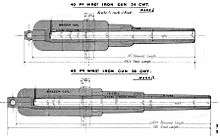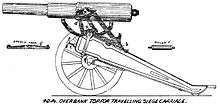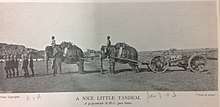RML 40-pounder gun
The RML 40-pounder gun was a British rifled muzzle-loading siege and fortification gun designed in 1871. It was intended to supersede the RBL 40-pounder Armstrong gun[3] after the British military reverted to rifled muzzle-loading artillery until a more satisfactory breech-loading system than that of the Armstrong guns was developed.
| RML 40-pounder gun | |
|---|---|
 Short Mk I barrel and lengthened Mk II barrel | |
| Type | Heavy field gun Fortification gun |
| Place of origin | United Kingdom |
| Service history | |
| Used by | British Empire |
| Production history | |
| Designed | Mk I : 1871 Mk II : 1874 |
| Specifications | |
| Mass | Mk I (34cwt) : 3,808 pounds (1,727 kg) Mk II (35cwt) : 3,920 pounds (1,780 kg) |
| Barrel length | Mk I : 85.5 inches (2,170 mm) bore (18 calibres) Mk II : 104.5 inches (2,650 mm) bore (22 calibres) |
| Shell | 40 pounds 2 ounces (18.20 kg)[1] |
| Calibre | 4.75 inches (121 mm) |
| Action | RML |
| Muzzle velocity | Mk II : 1,425 feet per second (434 m/s)[2] |
Description

The original Mk I short barrel of 18 calibres suffered from irregular velocity and hence accuracy, due to incomplete burning of the powder charge, hence only 20 were built.
The Mark II of 1874 with barrel lengthened to 22 calibres solved this problem and became the definitive model.[4]
The gun consisted of a central toughened steel "A" tube surrounded by wrought-iron coils, with a trunnion ring and cascabel. Rifling was the "Woolwich" pattern of three broad grooves, with a uniform twist of 1 turn in 35 calibres (i.e. in 166.25 inches).[5]
Service use

Four 40-pounders were used during the defence of Kandahar, during the 2nd Anglo-Afghan War in 1880.[6] Ten 40-pounder RML guns were landed in Egypt in 1882 as part of a Royal Artillery Siege train formed for the Anglo-Egyptian War, however none of them were deployed in action.[7]
The guns were also deployed at Forts and Batteries around Great Britain to form part of the fixed defences. In some cases special overbank carriages were issued for this use. They remained in this role until 1902, by which time most had been dismounted and scrapped.
Notes and references
- Text Book of Gunnery 1887, Table XVI, Page 313.
- 1,425 feet per second (434 m/s) firing a 40-pound-2-ounce (18.20 kg) projectile with 7 pounds (3.18 kg) of R.L.G.² powder. Text Book of Gunnery 1887, Table XVI, Page 313.
- Treatise on the Construction and Manufacture of Ordnance in the British Service, 1877, Page 260.
- Treatise on the Construction and Manufacture of Ordnance in the British Service, 1877, Page 260.
- Text Book of Gunnery 1887, Table XVI, Page 312.
- T A Heathcote (1974). The Indian Army, Newton Abbott, David and Charles, p181.
- Goodrich, Caspar F (Lt Cdr), Report of the British Naval and Military Operations in Egypt 1882, Navy Department, Washington, 1885, p.231
Bibliography
- Treatise on the Construction and Manufacture of Ordnance in the British Service. War Office, UK, 1877
- Text Book of Gunnery, 1887. LONDON : PRINTED FOR HIS MAJESTY'S STATIONERY OFFICE, BY HARRISON AND SONS, ST. MARTIN'S LANE
External links
| Wikimedia Commons has media related to RML 40 pounder gun. |
- Handbook for the 40-pr R.M.L. gun of 35 cwt. 1889 at State Library of Victoria
- Handbook for the 40-pr R.M.L. gun of 35 cwt 1897 at State Library of Victoria
- Diagram of 40pr. RML on Siege Travelling Carriage Mark II at Victorian Forts and Artillery website